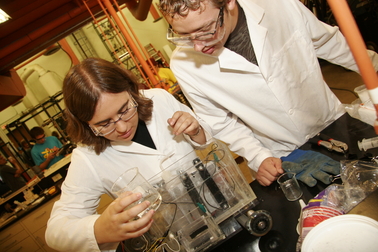
Putting chemical power to the test
Posted: November 01, 2010

Chemical engineering students Alison Davis (left) and Andrew Chesley perform labs tests in preparation for the national Chem-E-Car competition. Photo: Blaine Coury/ASU
ASU engineering students vying against formidable competition in national contest
A team of Arizona State University engineering majors is gearing up for a national student competition to design a vehicle powered by alternative fuels.
The Chem-E-Car competition organized by American Institute of Chemical Engineers will take place Nov. 6-7, in Salt Lake City. ASU’s team will go up against student engineering teams from about 30 other universities, including Stanford, Cornell, and Texas A&M.
ASU’s team members are chemical engineering undergraduates Jacob Lenzi, Luis Moya, Tara Smith, Kyle Foster, Alison Davis, Brian Anderson, Andrew Chelsy, Mike Rosauri, and mechanical engineering undergraduate Mark Garrison.
In the Chem-E-Car Rocky Mountain Regional competition last spring at the University of New Mexico, they took first place for most the creative vehicle design, first place in the project poster presentation, and third place overall.
The contest requires teams to design and construct chemically powered shoebox-sized vehicles that produce a chemical reaction to start and stop the vehicles. Teams are told only hours before the start of competition about the distance their cars must travel and the weight of cargo that each vehicle must carry.
Since the regional competition, the team has made some refinements to their vehicle. Because the base plate cracked during the regional competition, they had to machine another plate from Plexiglas, using a polycarbonate to prevent another break.
Team members are also testing different metals to use in their vehicle’s reaction vessel. In the regional contest, they used aluminum because of its heat-transference qualities. But it still experienced performance problems, so they’re considering use of copper.
What students learn through the competition can be applied in large-scale engineering efforts, Moya says.
Techniques used to build such vehicles can also be used by power plants. “If you are generating heat, you are already emitting some gases, and if you can recover some of that excess heat and create electricity, then you could use that to benefit a power company. That would be good for a community,” Moya says.
The team hand-built its car in a mechanical engineering machine shop, with assistance from Fred Pena, a research lab manager in the School for Engineering of Matter, Transport and Energy.
Davis says the hands-on approach provides a good learning experience. “We built this car from scratch, so we had to go to the machine shop on campus and learn how to use the machine to put everything together. As chemical engineers, we’ve never done that before,” she says.
Moya says the competition is intense, “but it’s a lot of fun.”
The team has received support from the USG Corp., ASU’s Ira A. Fulton Schools of Engineering, and several local companies, including Schlumberger, Abbie Gregg Inc., Air Products and Salt River Project utility company.
Written by Amy Lukau



































